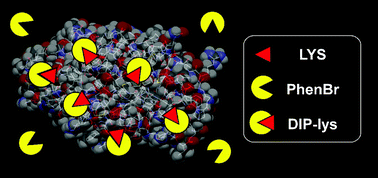Incorporation of N-heterocyclic cations into proteins with a highly directed chemical modification†
Abstract
N-Heterocyclic cations are incorporated into

* Corresponding authors
a
WestCHEM, Department of Chemistry, The University of Glasgow, University Avenue, Glasgow, UK
E-mail:
L.Cronin@chem.gla.ac.uk
Fax: +44-141-330-4888
Tel: +44-141-330-6650
b Instituto de Nanociencia de Aragon, Universidad de Zaragoza. C/ Pedro Cerbuna 12, Zaragoza 50009, Spain
c Department of Electronics and Electrical Engineering, University of Glasgow, Glasgow, UK
d Department of Biochemistry and Molecular Biology, Institute of Biomedical and Life Sciences, Joseph Black Building, University of Glasgow, Glasgow, UK
N-Heterocyclic cations are incorporated into

 Please wait while we load your content...
Something went wrong. Try again?
Please wait while we load your content...
Something went wrong. Try again?
N. McMillan, L. V. Smith, J. M. de la Fuente, A. D. C. Parenty, N. Gadegaard, A. R. Pitt, K. Thomson, C. MacKenzie, S. M. Kelly and L. Cronin, Chem. Commun., 2007, 2581 DOI: 10.1039/B702575K
To request permission to reproduce material from this article, please go to the Copyright Clearance Center request page.
If you are an author contributing to an RSC publication, you do not need to request permission provided correct acknowledgement is given.
If you are the author of this article, you do not need to request permission to reproduce figures and diagrams provided correct acknowledgement is given. If you want to reproduce the whole article in a third-party publication (excluding your thesis/dissertation for which permission is not required) please go to the Copyright Clearance Center request page.
Read more about how to correctly acknowledge RSC content.
 Fetching data from CrossRef.
Fetching data from CrossRef.
This may take some time to load.
Loading related content
